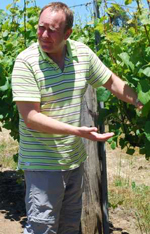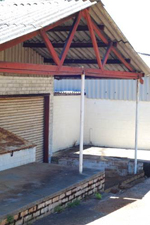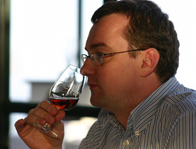A Man Named Keith: Moss Wood
Since I spend much of my time in French wine regions such as Bordeaux and Burgundy, I rarely encounter vignerons or maître-de-chais called “Keith”. It has taken over a decade before I met a “Keith”, but the “Keith” was one worth waiting for. I first met Keith Mugford of Moss Wood at an annual “Coonawarra Cabernet Masterclass” in 2007, where the home team was about to be pitted against their Margaret River cousins. I was in a haze of acute jetlag and had done little preparation, which admittedly had bugger all to do with jetlag…but it offered a legitimate excuse at the time. Keith sashayed into the hall, unable to shake my hand as he was laden with literature and research papers. He was positively brimming with energy, eagerly anticipating how the crème de la crème of each region would compare.
The pangs of guilt intensified. I would have to wing it, but just keeping my eyes open was difficult enough. Fortunately, the calibre of wines alerted and revivified the senses and the ensuing debate was thoroughly enlightening. As it turned out, my own personal highlight was unveiled as Moss Wood Cabernet Sauvignon 1985, a beauty as entrancing as almost any Claret I have encountered from that fecund vintage. So when I ventured down to Keith’s neck of the woods, I made sure that his winery was one of my first ports of call.
History
The roots of Moss Wood stretch back to the fledgling days of Margaret River. The original block of vines comes from a plot of land that Bill Pannell persuaded its owner, Jack Guthrie, to part with in 1969. Along with his wife Sandra, he began preparing the land and the first cuttings of Cabernet were planted two years later, offering up their first vintage of 250 cases in 1973. (Incidentally, these inaugural releases hit the headlines in 2007 when one bottle of ‘73 went under the hammer for an extraordinary AUS$2,301 at Langton’s auction: the highest price ever paid for a post-1970 bottle of Australian fermented grape juice.) The plot of Cabernet was augmented with Pinot Noir and Semillon in 1977, although the latter had been produced privately the year before. A small crop of Chardonnay debuted in 1980, although the next two vintages failed and it was not until the 1983 vintage that the public got their first sniff of it.

(Keith Mugford at home with his vines.)
By that time Moss Wood was entering a new era. Roseworthy-trained Keith Mugford had tenured at Tullochs and Orlando before signing on at Moss Wood as winemaker in 1978. “Bill had a problem with the 1978 crop, which is why he employed me,” explained Keith. “There was a clone mutation and the wine fermented differently. This caused a problem with sulphides and after filtration he found the wine had become flat. He ended up selling it for AUS$2.50/btl whereas the ’77 had sold for AUS$3.50/btl. ”
Keith debuted with the 1979 vintage (see tasting notes below.) Along with his wife Clare, they bought the winery in July 1985 and began investing in the vineyard, planting other grape varieties to complement the Cabernet Sauvignon and re-trellising the vines. Ian Bell was recruited as assistant vineyard manager and in 1989 he became assistant winemaker. Expansion continued with the acquisition of the 6.36ha Ribbon Vale Vineyard in 2000 in Wilyabrup, blessed with similar, classic gravel-loam soil of clay subsoil and these vines were planted in 1977. Although the wines are treated exactly the same as at the original Moss Wood vineyard, the clones are different and the wines are kept separate. Ian Bell resigned in 2006 to embark upon his own venture: Glenmore Wines in Yallingup and Josh Bahen, who has worked at Moss Wood since 2002, has stepped into his shoes.
The Vineyards
Like Vanya Cullen, Keith is one of those winemakers whose natural environment is amongst his vines. The original block consists of 11.78ha on gravel and red-brown loam over clay with no irrigation, the composition of plantings: 5.43ha of Cabernet Sauvignon, 0.29ha of Cabernet Franc, 0.03ha Merlot, 1.83ha Semillon, 2.17ha Chardonnay, 1.55ha Pinot Noir and 0.48ha Petit Verdot. Keith emphasized how important it was to change the trellising of the vines towards Scott Henry (Chardonnay and Pinot Noir) and Te Kauwhata Two Tier (Cabernet Franc, Merlot and Petit Verdot.) This has not only reduced yields but also facilitated vineyard husbandry in terms of picking and pruning. The original block of Cabernet was augmented with a further two hectares in September 1999 that included a little Petit Verdot and Cabernet Franc and these will be blended into the main blend from 2006. Of course, Bordeaux is an obvious inspiration in terms of vineyard planting except that there is less emphasis upon Merlot, a subject upon which I will return to later.
Keith sources fruit from several other assiduously chosen vineyards after the 1996 season denuded him of sufficient fruit. These include the aforementioned Ribbon Vale Vineyard, Green Valley Vineyard and Lefroy Brook Vineyard. Keith also makes the Cabernet at the Montgomery Vineyard that is sold to Sydney super-chef Tetsuya Wakuda for his restaurant’s own label. Fruit from the Glenmore Vineyard owned by Ian Bell was blended into the Moss Wood Cabernet from 1997 and from 2002 is has been bottled separately as “Amy’s Blend” after Ian’s grandmother who owns the land. (For detailed information on these holdings, refer to Moss Wood’s official website.) With respect to the 2008 vintage, the Moss Wood Cabernet was sourced solely from their own vines.
The vineyards were ploughed until 1980 and now Keith is experimenting with minimum tillage, mulching and cover crops, mainly legumes and “bulky” plants. He employs a controlled spray program on a 14-day rotational basis using copper and sulphur with four sprays during flowering to inhibit botrytis. Crop-thinning is only practiced for the Cabernet Sauvignon and the entire crop is picked by hand.
The Winery

(Is this the most boring photograph I have ever published? Probably. But this is the original Moss Wood winery and there is only so much photo-shop can do.)
Let me be honest, Moss Wood’s reputation is not reflected in the aesthetic aspirations of the winery that patently has functionality at its heart. There is nothing wrong with that in by book. After all, how many ostentatious wineries blithely churn out lacklustre wine? Certainly just by walking round the hotchpotch of buildings, Moss Wood has remained close to its roots. There is nothing to indicate an inflated ego or self-aggrandisement, which is reflected in the down-to-earth, personable nature of Keith himself. Yes, I am sure he welcomes visitors with appointments, but if you seek sculpted gardens or restaurant facilities, head for Leeuwin or Xanadu.
Over the years, Keith has tweaked the Cabernet Sauvignon by increasing the length of skin contact and by blending Cabernet Franc (5%), Merlot (0.5%) and from 1995 he has seasoned his wines with 5% of late-ripening Petit Verdot. The Ribbon Vale wines are based on a ratio of 60% Cabernet Sauvignon, 30% Merlot and 10% Cabernet Franc and are fashioned in a slightly fleshier, rounder style. Fruit is de-stemmed and alcoholic fermentation is through cultured yeasts. The wines used to be raised in 300-litre barrels but nowadays there is a move towards 225-litre barriques, mainly Seguin-Moreau, Raymonde and Rousseau, with a couple sourced from a Bordeaux First Growth no less. The “Amy’s” tends to use less new oak, around 25%, compared to the Moss Wood Cabernet that utilizes around 50-55% depending on the vintage. In the past, Moss Wood has released a Cabernet Reserve, the last release in 1994, but this has been discontinued.
The Pinot Noirs follow Burgundian tenets: whole-bunch crushing and manual hand and feet plunging during fermentation. The Chardonnay is raised in oak barriques for 18-months without lees-stirring and most barrels going through malolactic.
The Wines
Interestingly Keith collated his vintages into three groups. “Cool years have a fine texture, less concentration and a ‘gritty astringency’,” he explained, “which would be vintages such as 1982, 1987, 2002 and 2006. Hot years included 1976, 2000 and 2007 that have a ‘sumptuous generosity’ and are earlier drinking. The best years I would say are 1975, 1980, 1985, 1990, 1995, 1996, 2001 and 2005 where you obtain mulberry and black fruits, cigar and a touch of leafiness. There was a period between 1982 and 1987 where the Cabernets were leafier…you couldn’t make wines like that now…styles have become more market driven.”
There is a sense of honesty to Moss Wood’s Cabernet Sauvignon; a wine that reflects the growing season, for better or for worse. For example, I cannot avoid the vegetal notes on the Cabernet Sauvignon 2006, now tasted 3-4 times. Cropped on 14th April it represents a brave attempt to extricate ripeness from a cool summer, but I cannot help but feel this wine fell at the last hurdle. For this writer, I much prefer the stunning Cabernet Sauvignon 2007 that Keith compares to the legendary 1976. Cropped on 6th March and delivering a healthy 14.5% alcohol, this is unadulterated Margaret River Cabernet at its very best: a complex, ethereal bouquet that keeps the senses on their toes, picking out aromas of cold tea and cedar from the brambly black fruit, the palate beautifully, succinctly balanced with an intriguing “maltiness” coming through on the finish (something I sometimes discern on François Mitjavile’s wines in Saint Emilion.) The Cabernet Sauvignon 2008 is a little more structured and broody at the moment, but already displays great concentration and focus, perhaps just missing the flair of the previous vintage, although that should develop in bottle of course. The barrel sample of Cabernet Sauvignon 2009 was similarly showing great potential although at this premature juncture, it just lacked a little persistency on the finish. I look forward to tasting both in bottle.
I tasted one mature vintage that turned up at a private dinner for judges at the highly recommended “Must” restaurant in Margaret River (article to follow separately.) The Cabernet Sauvignon 1979 was actually served against my own offering, a Château Pichon-Baron 2005 that was in top form. But Keith’s debut vintage more than held its own, despite just a faint hint of TCA on the nose. The palate was remarkably fresh and vital, a doppelganger for a fine Left Bank Bordeaux and in my estimation, better than many from that vintage! These old wines are now impossibly rare and unsurprisingly Keith regards the triumvirate of 1975, 1976 and 1977 as Moss Wood’s benchmarks.
Stylistically, Moss Wood’s Cabernet’s are strictly Left Bank, perhaps more Northern Médoc in style. They often bring to mind a fine Saint Estèphe is terms of their comparatively more austere structure and their uncompromising nature. They demand respect, they demand patience on behalf of the wine-lover and their charms and personality are not fully revealed until 8-15 years. However, they certainly flourish with age as evinced by the two older wines. Their Cabernets develop lovely mulberry aromas mixed with a little mocha or dark chocolate, the palate retaining a sturdy backbone but melted gradually with every turn of the calendar. I do ask myself whether the Cabernet Sauvignon would benefit from a higher percentage of Merlot, just to lend a little suppleness? Personally, I would be intrigued to see how say, 15% marries with the Cabernet and the Petit Verdot, but of course, that is up to Keith and the limitations of his terroir.
At least this time I was not as jet-lagged as in Coonawarra and I was not looking for a barrel behind which I could curl up and catch forty winks. Unfortunately, I was still not sufficiently alert to spot a rare bottle of ’76 Moss Wood on a UK wine list when I returned home…for £33. Bugger.
Tasting Notes
1979 Moss Wood Cabernet Sauvignon 92
Tasted blind at Must restaurant in Margaret River. Wow, what a wine…despite just a touch of TCA on the nose. But that taint cannot disguise a wonderful bouquet of blackberry, earth, sandalwood, cedar and cigar box. The palate does not seem affected at all: wonderful delineation with a ripe entry, touches of mulberry and liquorice mixed with a little undergrowth, silky and fresh as a daisy on the Médoc-like finish. Sublime. Drink now. Tasted November 2009.
2006 Moss Wood Cabernet Sauvignon 85
Having tasted this wine two or three times, I have to say that I think the challenging vintage overcame this wine. The vegetal notes on the nose are unavoidable, very peppery and stalky. The palate is medium-bodied with chewy tannins, very leafy and clipped on the finish. Skip straight to the ’07. Drink now. Tasted November 2009.
2007 Moss Wood Cabernet Sauvignon 94
This is an outstanding Cabernet Sauvignon from Moss Wood. It is a very complex, multi-faceted nose with blackberry, a touch of cassis, cold tea and cedar. The palate is medium-bodied and beautifully balanced with supple blackberry, bilberry, cedar and espresso, with a slight maltiness coming through on the finish. Real panache and style here. Excellent. Drink 2012-2020+ Tasted November 2009.
2008 Moss Wood Cabernet Sauvignon 91-93
The ’08 Cabernet Sauvignon sports a broody blackberry, slightly “dusky” nose with a touch of strawberry wine gums developing in the glass. The palate has a dense structure, cedar and liquorice infusing the black fruits that lighten up towards the linear finish that will need time to coalesce in bottle. The focus, the intention here is captivating. Drink 2011-2020+ Tasted November 2009.
2009 Moss Wood Cabernet Sauvignon 89-91+
Ebullient black fruit on the nose with raspberry, blackberry leaf and a touch of wet clay, all wrapped up with excellent delineation and focus. The palate is sensuous on the entry with mulberry and liquorice tinged fruit, subtle grainy tannins and a delectable touch of leafiness on the finish that frustratingly just finishes earlier that I would have liked. Hopefully this will flesh out by the time of bottling. Tasted November 2009.
2007 Moss Wood Ribbon Vale Merlot 86
This merlot is a little simple and one-dimensional on the nose. Supple red-berried fruit on the palate, rounded and perhaps just a little commercial, though the wild strawberry/raspberry finish comes across as elegant and refined. Drink now-2011. Tasted November 2009.
2007 Moss Wood Ribbon Vale Cabernet Sauvignon/Cabernet Franc/Merlot 90
This has a savoury bouquet, perhaps the Cabernet Franc occupying the driving seat, whilst the medium-bodied palate displays impressive weight and concentration matched with vibrant acidity, hints of dark chocolate and cedar towards the tannic finish that still shows great clarity. Very fine, nice combination of Old and New World. Drink 2011-2018. Tasted November 2009.
2008 Moss Wood Ribbon Vale Cabernet Sauvignon/Cabernet Franc/Merlot 88
Here the Merlot constitutes 40% of the blend. It has a slightly more opulent black cherry and bilberry scented nose with just a touch of chestnut. Compared to others wines, it leans more towards the New World/Antipodean style of Bordeaux blend, although it retains fine balance on the digestif finish. Tasted November 2009.
2009 Moss Wood Ribbon Vale Cabernet Sauvignon/Cabernet Franc/Merlot 89-91
A blend of 70% Cabernet Sauvignon, 25% Merlot and 5% Cabernet Franc, this is relatively closed on the nose, but unfurls nicely in the glass with blackberry, plum and a touch of bay leaf. The palate has a talcum texture, supple blackberry laced with espresso, leading to a tannic, slightly austere finish. Very fine. Tasted November 2009.
2009 Moss Wood Pinot Noir 87
A clean fresh entry with fresh black plum, cranberry and dark cherry, the palate quite tart and pointed at the moment, notes of cranberry and raspberry, but pulling up a little short towards the finish. Not bad though. Tasted November 2009.
2008 Moss Wood Amy’s 90
The ’08 Amy’s Blend is 71% Cabernet Sauvignon, 11% Malbec, 11% Petit Verdot and 7% Merlot. It has a fleshy, mulberry and boysenberry scented bouquet with just a hint of toffee. Lively and supple on the palate, though quite linear in its infancy, firm tannins coming through more towards the finish with just a touch of dark chocolate. Very fine. Drink 2011-2015. Tasted November 2009.
2009 Moss Wood Amy’s 88-90
This wine had just been racked from barrel and exuded brambly black fruits on the notes, raspberry and just a faint hint of espresso. Nice weight on the palate with powdery tannins, expressive and taut on the finish. Fine. Tasted November 2009.
2008 Moss Wood Chardonnay 90
The ’08 Chardonnay has an attractive, quite nutty bouquet with cashew and litchi inflecting the crisp citrus aromatic profile. Very fine definition, with a puff of chalk dust discernible in the background. The palate is well balanced with nectarine, dried apricot, lime and passion fruit, a slight bitterness on the finish. Fine, although I think the ’09 will turn out better. Drink 2010-2016. Tasted November 2009.
2009 Moss Wood Chardonnay 91-93
A clean fresh bouquet with lifted citrus fruit: pineapple, cooking apple, almond and Conference pear. Fine tension on the palate with subtle tropical fruit inflected with hints of hazelnut, leading to an incisive finish with a hint of pear drop on the aftertaste. Great potential. Tasted November 2009.
2009 Moss Wood Semillon 90-92
This Semillon has a sharp, well-defined nose with green lemon, sherbet, Kaffir lime and fine mineralité. The palate is well balanced with fresh green lime, dried pineapple, nectarine and a hint of ginger. Good length. Just lovely. Tasted November 2009.
2009 Moss Wood Ribbon Vale Semillon/Sauvignon Blanc 88-90
A blend of 68% Semillon and 32% Sauvignon Blanc, this has a ripe pineapple and lemon sherbet bouquet, cooking apple budging the Semillon aromas aside with further aeration. The palate has a soft, almost talcum texture with subtle tropical fruit, pineapple and passion fruit, long and well defined on the finish. Fine. Tasted November 2009.

